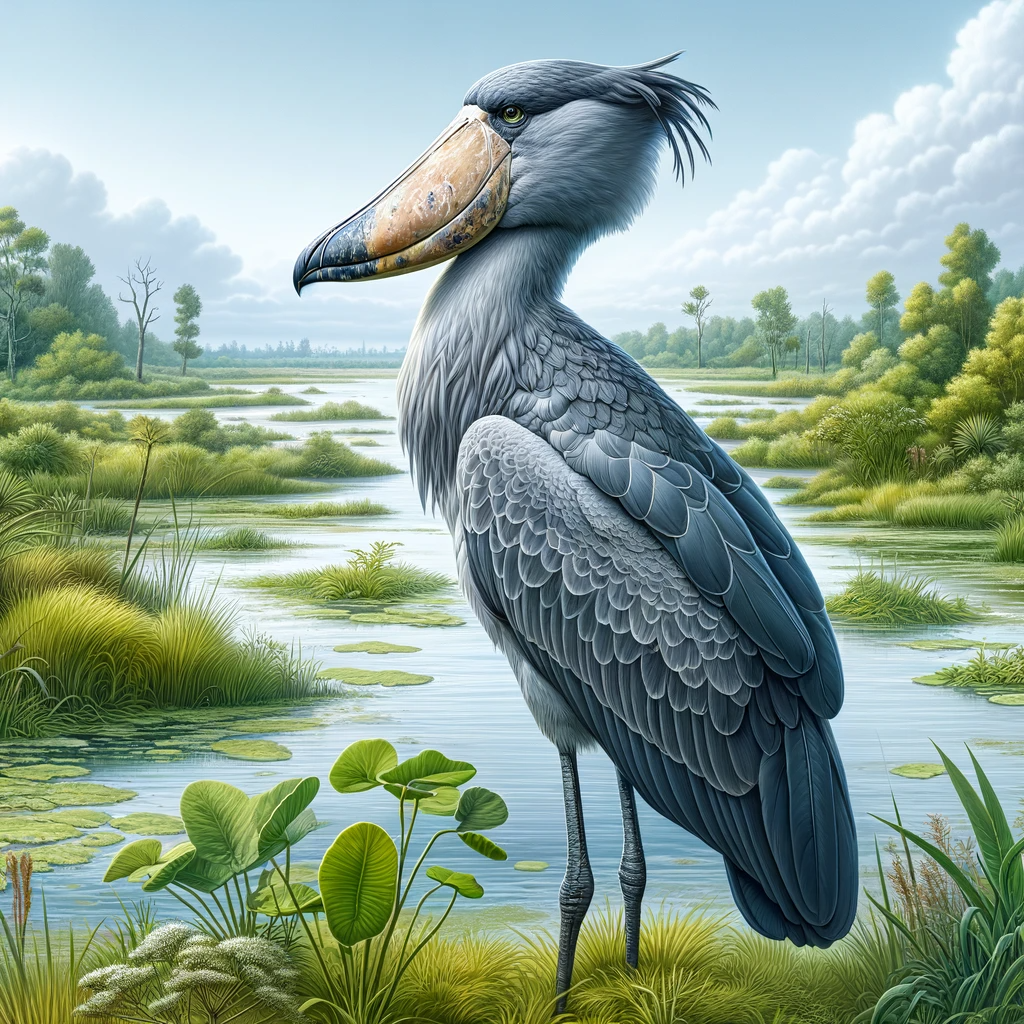Shoebill stork
The Shoebill: Africa’s Enigmatic Giant
Introduction
The shoebill (Balaeniceps rex) is a remarkable and enigmatic bird species that inhabits the wetlands and swamps of tropical Central Africa. With its distinctive appearance and fascinating behavior, the shoebill has captured the imagination of bird enthusiasts and researchers alike. In this 1500-word essay, we will delve into the world of the shoebill, exploring its physical characteristics, habitat, behavior, conservation status, and the cultural significance it holds in the regions it calls home.

Physical Characteristics
The shoebill is a large bird, often described as prehistoric in appearance due to its unique features. It stands at an impressive height of around 4 to 5 feet (120 to 150 centimeters) and has a wingspan of approximately 7 to 8 feet (210 to 230 centimeters). What truly sets the shoebill apart is its enormous, shoe-shaped bill, which can grow up to 9 inches (23 centimeters) in length. This bill is broad at the base and ends in a sharp hook, making it well-suited for capturing prey.
The shoebill’s plumage is predominantly gray-blue, with a lighter, almost silvery color on its back and wings. It has a tall, straight neck, a large head, and striking golden-yellow eyes. The eyes, combined with its intense stare, give the shoebill a somewhat intimidating and regal appearance.
Habitat and Range
Shoebills are primarily found in the wetlands and swamps of tropical Central Africa. Their range extends across a broad area that includes countries such as South Sudan, Uganda, Congo, Tanzania, and Zambia. Within these countries, shoebills inhabit a variety of wetland environments, including freshwater swamps, marshes, and the papyrus-lined shores of lakes and rivers.
These birds are highly specialized for their chosen habitat. The wetlands provide them with a consistent source of food, which primarily consists of fish, frogs, and aquatic insects. The shoebill’s large bill is an essential tool for capturing prey, and its long legs allow it to wade through the water with ease. It is also an excellent swimmer and can use its webbed feet to navigate through the water efficiently.
Behavior and Diet
Shoebills are known for their patient and stealthy hunting techniques. They often stand motionless for hours at the water’s edge, waiting for their prey to come within striking distance. When an unsuspecting fish or amphibian approaches, the shoebill rapidly strikes, using its bill to grasp its prey with remarkable accuracy and force. The sharp hook at the tip of its bill helps secure a firm grip, ensuring that the prey cannot escape easily.
The shoebill’s diet primarily consists of fish, but it is known to consume a variety of other aquatic creatures as well. This adaptability in diet allows the shoebill to thrive in different wetland ecosystems. However, they are also opportunistic hunters and may prey on other small mammals or birds when the opportunity arises.
Reproduction and Life Cycle
Shoebills are solitary birds for most of the year but come together in pairs during the breeding season. The breeding season typically coincides with the dry season when water levels in their habitats are lower, making it easier for them to find food and build nests.
Shoebills construct large, flat nests made of reeds, sticks, and other plant materials. These nests are often situated in areas surrounded by water to provide protection from land-based predators. A pair of shoebills will work together to build the nest, with both male and female contributing materials.
After the nest is completed, the female typically lays one to three eggs. Both parents take turns incubating the eggs, which hatch after about 30 to 40 days. The chicks are initially covered in down feathers and are entirely dependent on their parents for food and protection. They grow rapidly, and within a few months, they begin to develop their characteristic bill shape.
Conservation Status
Despite their impressive appearance and unique characteristics, shoebills face several threats to their survival, primarily due to habitat loss and human activities. Wetland destruction, drainage for agriculture, and deforestation in their range have all contributed to the decline of shoebill populations.
Additionally, shoebills are vulnerable to disturbance by human activities such as tourism, which can disrupt their breeding and feeding habits. The demand for the shoebill’s large, striking bill in the illegal wildlife trade has also posed a significant threat to their population, as they are often killed for this unique feature.
Conservation efforts are underway to protect shoebills and their habitats. These efforts include the establishment of protected areas, wetland conservation initiatives, and raising awareness about the importance of preserving these remarkable birds.
Cultural Significance
In the regions where shoebills are found, they hold cultural significance for local communities. Shoebills are often regarded as symbols of wetland ecosystems and are sometimes associated with myths and legends. Some African cultures view the shoebill as a sacred bird, representing both the beauty and fragility of their natural environment.
Furthermore, the presence of shoebills in wetlands can have positive effects on local economies through ecotourism. Birdwatchers and nature enthusiasts from around the world travel to see these magnificent birds in their natural habitats, contributing to the local economy and fostering a sense of pride and responsibility for their conservation.
Conclusion
The shoebill, with its striking appearance, unique behavior, and cultural significance, is a captivating bird species that has carved a niche for itself in the wetlands of tropical Central Africa. As a species facing threats from habitat loss and illegal trade, the conservation of shoebills is of paramount importance. Efforts to protect these remarkable birds, their wetland habitats, and the communities that coexist with them are vital to ensure their continued survival in the wild. The shoebill serves as a reminder of the incredible diversity of life on our planet and the urgent need to protect and preserve it for future generations.
Read about other birds in Uganda